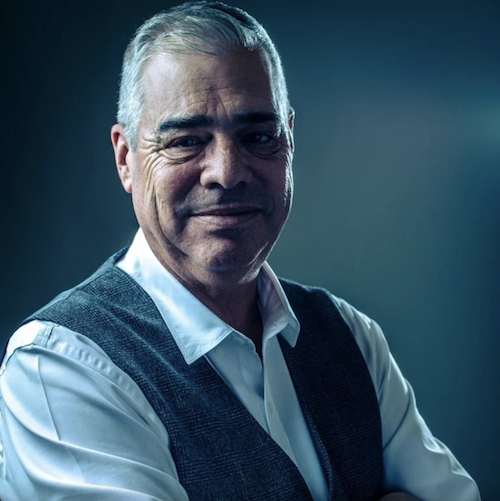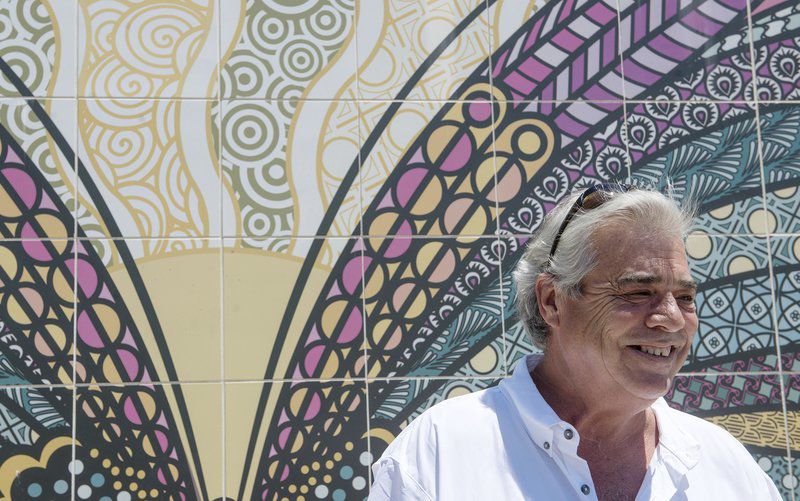For mural coordinator Paul Whitehill, of Joplin, historic Route 66 is more than just a famous highway: It’s an opportunity to tell a story for future generations to enjoy.
“Murals can tell a story about an individual, a community, a city, a state or a country,” Whitehill said. “These stories are generally told with art. I’ve been involved in so many mural projects, and some of my favorite are public art murals because we’re preserving a time in history for generations to see and appreciate.”
Whitehill completed three tile murals in Boswell Park in Lebanon, Missouri, as part of a Route 66 project launched a few years ago. With the project, he aims to create long-lasting murals in each of the eight states that the Mother Road runs through with the intent of preserving history and revitalizing the towns.
The third mural in Lebanon was dedicated May 6 and pays homage to the Nelson family, who operated several roadside services along the route including Nelson Tavern and Nelson’s Dream Village. The tile mural is called “Nelson Family Legacy,” and four generations of the family attended the ceremony for the debut.
“The murals we did out in Lebanon are all Route 66 themed,” Whitehill said. “Lebanon was very strong and rich in the history of Route 66. Of the three murals, we were able to celebrate the historical significance of Route 66 in the city of Lebanon and also within Laclede County. Then, we also honored the family that owned a lot of the Route 66 hotels and restaurants. The three murals share the history of Route 66 in Lebanon.”
Whitehill has helped complete five other tile murals along Route 66 including the one in Galena on 7th and Main and the two on the south side of Pearl Brothers True Value Hardware in downtown Joplin. He’s currently working on a large-scale mural in Los Angeles that will coincide with the centennial celebration of Route 66 in 2026.
Other murals
One of Whitehill’s most iconic creations is the butterfly mural in Mercy Park, which was dedicated in 2016 on the five-year anniversary of the Joplin tornado. Two hundred multicolored tiles with an array of designs construct a 10-foot-tall, 20-foot-wide butterfly with two flowers on each side of the wings.
Whitehill said the butterfly serves as a symbol of life and recovery.
“My graphic design team came up with the design for this, and the butterfly is full of all different kinds of patterns, which is symbolic of our lives,” Whitehill said, standing in front of the mural. “The destruction of the tornado and the event disrupted those patterns. We were able to incorporate that into the butterfly as a symbol of recovery.”
On the reverse wall of the butterfly mural is a mural Whitehill coordinated with Art Feeds called “Together We Create,” which was exhibited in May. Last year, about 50 elementary students participated in three-hour mural workshops hosted by Art Feeds where students expressed themselves through art and created the mural.
“The artwork is the children’s vision of what Mercy Park is,” Whitehill said. “It’s fun and whimsical. There’s dragons, fairies and ice cream cones. In a case like this, Art Feeds creates all of the artwork and then submits it to me. I take it from there and have it manufactured and installed.”
A mural Whitehill is most particularly proud of is the Roger Federer Mural at the Indian Wells Tennis Garden in California. The murals were unveiled in March during the beginning of the 2018 BNP Paribas Open where Roger was ranked the No. 1 men’s tennis player in the world.
In 2017, Whitehill was with his father, Barney, who is a huge Federer fan, in California. The father and son watched the tennis player win at the Australian Open in January and, later, winning at Indian Wells in California. Whitehill said he dedicated the Federer mural to his father, who died three weeks after.
“He was excited, and he knew I was going to be doing it,” he said. “That one will be forever special.”
Tile-making process
In 2001, Whitehill started Images in Tile in Joplin, a local tile-manufacturing business. He then pursued a solo career in 2013 where he began Whitehill Enterprises in Webb City, a private consulting firm specializing in public art and custom tile murals.
All of the tile murals are produced and printed digitally. Whitehill works with a group of artists and graphic designers, and they create a concept that can be easily altered or changed to fit the needs of the client or the community.
“We do all of the design work, the manufacturing, the installation,” Whitehill said. “A lot of murals I do, I ship them out to clients, and they install it themselves.”
Whitehill compared the tile making process to pottery and how the tiles are processed through kiln fired ceramic toners. Once the ceramic or porcelain tiles are constructed, the ceramic toners paint an image onto it and then it’s fired in the kiln. A second process called dye sublimation utilizes a heated printer to transfer dye onto the tiles. Whitehill said this is used in all their interior work.
“When I’m called to come out to a project, it’s not just putting the image on the tile; it’s really a mechanical thing,” he said. “There’s a process to do both interior and exterior. What it really comes down to is working with the client where we discuss what size tiles, what types and what type of finish. This is my main job to get this all organized for the client and figure out exactly what we need and make samples for them.”
Unlike regular murals that fade within eight to 10 years, the tile murals aren’t affected by UV rays or weather. After the tiles are created digitally, they’re added to the canvas wall by using an adhesive that allows them to last a lifetime.
The longest proces is the artwork, which takes longer than the manufacturing of the tiles.
“Creating art on a grand scale like that takes specialized equipment, computers, graphics programs,” Whitehill said. “Making a digital file that big takes a while. Let’s say the artwork took four to six weeks. Manufacturing of the tiles takes a couple of weeks. We finished the butterfly installation in about three days.”
In total, Whitehill said he’s been coordinating tile murals for about 16 years.
“I’ve done a lot of things in my life, and these murals are by far the proudest things I’ve ever done,” he said.
Source: The Joplin Globe | August 19, 2018


Recent Comments